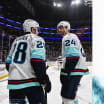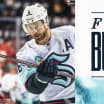Kaleta did that, and then some; he scored four goals in a 6-5 loss at Maple Leaf Gardens. One day - and a lot of media attention to 'Alex Kaleta's hat trick' later - the hat was his.
"There was no rhyme or reason to it," Taft told The Hockey News in 1992. "I just, for some reason, said 'You go out there and score three goals tonight and I'll give you the hat.' Sure enough, he went out there and knocked in three goals.
There was plenty of "rhyme and reason" to Eberle's goals Thursday.
The first one came 26 seconds after Buffalo's Kyle Okposo had scored on a power play in the second period to give the visitors a 2-1 lead, despite the Kraken heavily outshooting Buffalo. It started with Schwartz again, who had the puck behind the net and found Eberle in the slot to get the game square.
In the post-game media scrum, Eberle said he noted twin video boards showing the Kraken had tripled the Sabres' shots on goal ("25 to 8, I think") before he knotted the game at 2-2 before second intermission.
It didn't take long in the third to take the lead. Eberle made a move to get past a defender, caught Tokarski leaning and slid the puck in on the stick side for goal number two. Seattle had a 3-2 lead.
"Those are big momentum shifts in a game we desperately needed to win," Eberle said. "You look at the standings, I know it's early, but you don't want to fall too far behind."
The hat trick goal was an insurance score and represents Eberle's fifth of the season. He's tied Jared McCann for the team scoring lead with seven points.
It was just a week and a half ago that Eberle had yet to find the back of the net. He now has five goals over his last five games.
Like the team, Eberle was getting chances but was struggling to break through with a goal. First, it was a goal a minute into the victory over Montreal. He followed that up two games later with a whirling backhand score against the New York Rangers, all leading up to Thursday's outburst.
He'd been saying he wasn't worried about the goals and that, as long as he, and the Kraken, were getting chances, the goals would come. Thursday, he put an explanation point on his keep-the-faith mindset with a historical first for the franchise.
"I've played a long time in this league, and you've just got to stick with it," Eberle said Thursday post-game. "It's cliché, but when you're not creating those chances, that's when you've got to start worrying. As long as they're there, some nights they go in and some nights they don't. It's just that simple."
Thursday's heroics resulted in him being the first star of the night in the hockey tradition of naming three stars. In a now-Kraken tradition, he launched a plush salmon deep into the stands to celebrate.
"I live downtown so I go to [Pike Place Market] with my little girl quite a bit to get groceries," said Eberle. "I see [the fishmongers] throw the fish, so I wanted to make them proud."
Hockey historian John Kreiser contributed to this article.



















